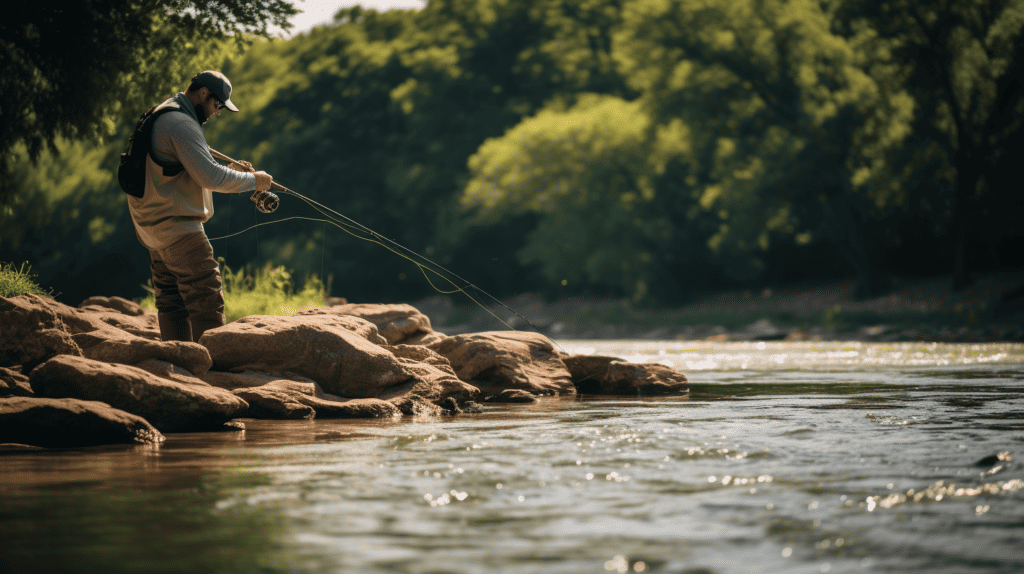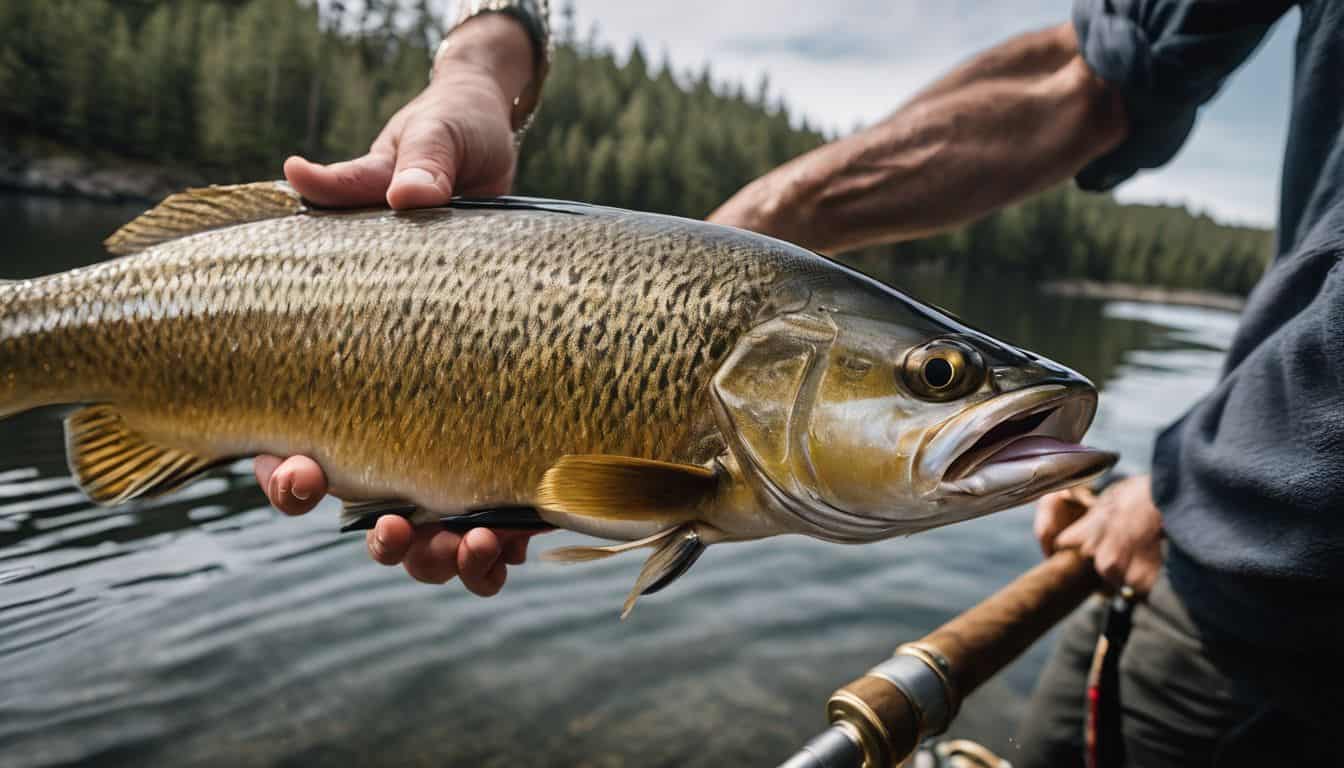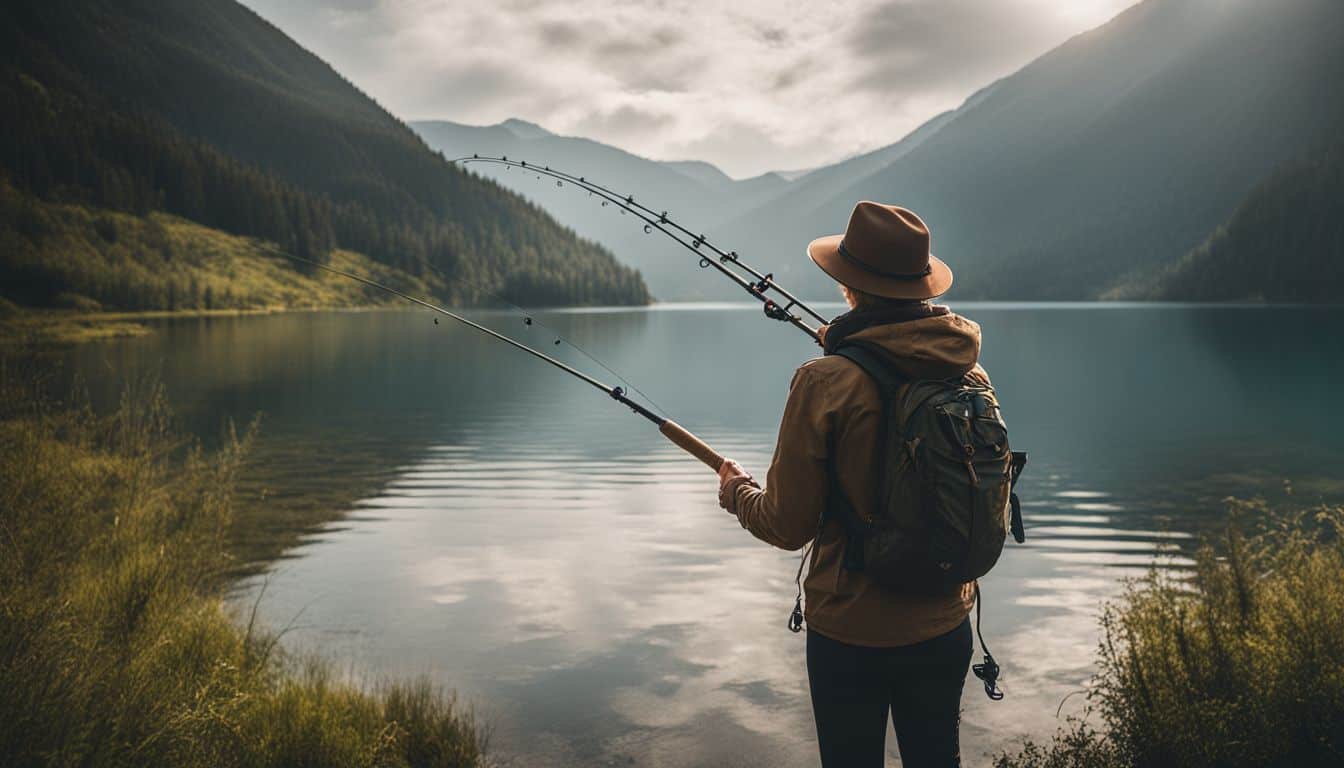Fishing isn’t just a hobby, it’s an art. Whether you’re a seasoned pro with countless catches under your belt or a fresh face on the dock, finding that perfect fishing line can feel like quite the quest.
But don’t worry, I’ve walked in those shoes myself. Through many sunrises spent casting and plenty of late-night research sessions, I’ve discovered how pivotal this choice truly is to reeling in a trophy catch.
This blog aims to equip you with 19 concrete tips for picking not only the right but also top-performing fishing lines fitted exactly to your unique needs. Ready to elevate your angling game? Grab your tackle box and let’s get into it!
Factors to Consider When Choosing Fishing Line
When choosing fishing line, it is important to consider factors such as line size and type, diving depth, braid to fluorocarbon ratio, and pound test selection.
Line size and type
Picking the right line size and type matters in fishing. Thick lines are strong but fish can see them. Thin lines are hard for fish to spot, yet they may break easily. The breaking strength tells you how much weight the line holds before it breaks.
Casting distance is another point to think about. A thin line can go a long way from the shore or boat! Diameter measurement helps know how thick or thin your line is. Among various fishing line types, you have monofilament, thermal, and braided lines as options.
Each has different characteristics because of their materials, designs, and colors used. Choose well based on what works best for you!
Diving depth
Diving depth matters a lot in fishing. Different fish swim at various depths, so your line needs to go deep enough. Lines can help lure dive deeper. For instance, deep-diving crankbaits sink more with the right line.
Line sinking ability changes how deep lures go too. Water conditions and line strength also impact it. An ideal line should have less stretch and memory but high abrasion resistance.
David Fritts says the cast’s length, angle, and accuracy matter along with lure choice for diving depth as well.
Braid to fluorocarbon
Braid lines have a lot of power. They do not stretch much. This makes them great for fishing in places with lots of plants or rocks. Fluorocarbon lines are different. They blend in with the water well and don’t get hurt by sharp things as much.
This makes them good for clear water and finesse fishing, where you need to be sneaky! To fish at your best, use the right mix of braid and fluorocarbon lines with your rod and reel.
Pound test selection
I always consider the pound test selection when choosing fishing line. It’s important because it determines the strength of the line and how much weight it can handle. For example, if I’m targeting smaller fish, a 6-10 lb test fishing line would be sufficient.
But if I’m going after bigger fish, like bass or pike, I would use a heavier line with a pound test of 15-20 lbs. The pound test is all about matching the strength of the line to the size and weight of the fish I’m trying to catch.
So, before heading out on my fishing adventure, I make sure to select a fishing line with an appropriate pound test for my target species.
Understanding Different Types of Fishing Line
When it comes to fishing line, there are three main types to choose from: monofilament, fluorocarbon, and braided. Each type has its own unique properties and advantages. Read on to learn more about these different types and which one might be best for your fishing needs.
Monofilament
Monofilament is a type of fishing line that works well with traditional spinning, spincasting, and casting reels. It has some special properties that make it useful for different situations.
Monofilament is buoyant, which means it floats on the water’s surface. It also absorbs water, so you need to dry it properly after each use.
One advantage of monofilament is its forgiving nature. It has some stretch to it, which helps absorb the shock when a fish tugs on your line. This can prevent your line from breaking and increase your chances of landing a catch.
Monofilament is also softer compared to other types of fishing line like fluorocarbon.
Another benefit of monofilament is its resistance to abrasion. Rocks or fish teeth can sometimes damage your line during a fishing trip, but monofilament holds up better in these situations.
That makes it suitable for beginners who might not have perfect casting skills yet.
Fluorocarbon
Fluorocarbon line is an important type of fishing line, especially when you’re using jigs in areas with lots of vegetation and cover. It’s really great because it doesn’t soak up water like other lines do, which means it won’t get heavy and sag in the water.
Fluorocarbon line is also hard for fish to see because it has the same refractive qualities as water, making it almost invisible underwater. This line is strong and has limited stretch, so you can feel even the slightest nibble from a fish.
Plus, it’s resistant to abrasion, so you don’t have to worry as much about it getting damaged by rough surfaces or sharp teeth. So if you’re into jig fishing or want a line that’s hard for fish to spot, fluorocarbon is definitely worth considering!
Braided
Braided fishing lines are a type of line that offer some unique advantages. One important thing to know about braided lines is that they have better cutting capabilities, especially when you’re fishing in areas with lots of grass or wooden structures.
This means that you’ll have an easier time maneuvering your line through those types of obstacles. Another great thing about braided lines is that they have little to no stretch. This can be really helpful because it allows you to feel even the slightest nibble on your line, making it easier to detect bites and catch more fish.
Braided lines are also really durable and abrasion-resistant, which means they won’t break easily even when rubbing against rocks or other rough surfaces underwater. Additionally, one advantage of braided lines is that they tend to be thinner in diameter compared to monofilament lines.
This can be beneficial because it allows you to fit more line onto your reel without sacrificing strength or performance. Overall, for many anglers, braided fishing lines offer different characteristics and advantages compared to other types of fishing lines like nylon monofilament, making them a popular choice in many fishing situations.
Key Features to Look for in Fishing Line
When choosing fishing line, it is important to consider key features such as castability, line stretch, memory, and strength.
Castability
Castability is a crucial factor to consider when choosing the right fishing line. It determines how far and accurately you can cast your line. The material used in fluorocarbon fishing line has excellent castability, allowing for longer and more accurate casts.
So if you want to make those impressive long-distance casts, fluorocarbon is a great choice. Another thing that affects castability is the thickness of the line. Using a thinner and lighter line will result in better casting performance compared to a heavier and thicker line.
Lastly, left-handed reels are believed to be superior for casting because they offer increased versatility, regardless of your dominant hand. So keep these things in mind when selecting the right fishing line for optimum castability.
Line stretch
Line stretch is an important factor to consider when choosing fishing line. Moderate line stretch is recommended for trolling because it helps prevent the hook from being ripped out of the fish’s mouth.
Braided fishing line has almost no stretch, which provides excellent sensitivity and feel for the angler. On the other hand, mono fishing line stretches more than braided line. Stretch in fishing line can vary depending on the type of line you choose.
So, if you’re looking for better hooksets and a good fight with the fish, considering the right amount of stretch in your fishing line is crucial.
Line memory
Line memory is an important factor to consider when choosing fishing line. It refers to the line’s ability to retain its shape after being spooled or stretched. Fishing lines with low memory are better because they are less likely to get tangled or create loops and twists.
Braid fishing lines typically have no memory, making them suitable for spinning reels. On the other hand, monofilament lines have higher memory compared to other types. To reduce line memory and prolong the lifespan of your fishing lines, it’s important to store them properly and perform regular maintenance.
Line strength
The strength of your fishing line is really important. It’s measured in pounds and called “test.” You need to make sure that the line strength matches the weight of the fish you want to catch.
That way, it won’t break easily when you’re reeling in a big one. If you use a braided line, it can handle more weight because of advancements in castability and break strength compared to its diameter.
Remember, we often call the strength of a fishing line its “breaking point.”.

Matching Fishing Line to Fishing Conditions
Choosing the right fishing line is important for success. Here are some tips for matching your fishing line to the conditions:
- Consider the weight of the fishing line. Different conditions require different line weights. A lighter line is better for clearer water and finicky fish, while a heavier line is needed for rougher conditions and bigger fish.
- Think about the type of fishing you’ll be doing. If you’re casting lures and need good sensitivity, a braided line may be best. If you’re fishing in clear water and want low visibility, fluorocarbon is a good choice.
- Pay attention to the depth you’ll be fishing at. If you’re going deep, consider using a sinking line or adding weights to your line. This will help get your bait down to where the fish are.
- Take into account the species of fish you’re targeting. Some species have sharp teeth or mouths that can easily break or cut through certain types of lines. Make sure your line is strong enough to handle the fight.
- Be aware of the weather conditions. Windy days require heavier lines that can cut through the wind and still deliver your bait accurately.
Essential Tips for Organizing Your Fishing Tackle for Growth
Organizing your fishing tackle is crucial for a successful day on the water. Here are some essential tips to help you keep your gear in order:
- Use a tackle box or tackle bag: Choose between a traditional tackle box or a more portable tackle bag based on your preference and fishing style.
- Sort by category: Separate your lures, hooks, sinkers, and other tackle items into different compartments or pouches to easily locate what you need.
- Label everything: Use waterproof labels or marker pens to label your boxes, bags, and compartments. This will save time when searching for specific items.
- Keep it clean: Regularly clean your tackle box or bag to remove dirt, debris, and rust. This will help prolong the life of your equipment.
- Upgrade storage options: Consider investing in additional storage solutions like utility boxes or hanging organizers to accommodate growing tackle collections.
- Check for damage: Before each fishing trip, inspect your tackle for any damaged items such as broken lures, frayed lines, or rusted hooks. Replace or repair as needed.
The Ideal Rod/Reel/Line Combos for Different Presentations
Fishing enthusiasts like us know that every presentation demands a specific rod, reel, and line combo for maximum effectiveness. Here’s a handy table to help you match the right gear to your favorite techniques.
| Technique | Rod | Reel | Line |
|---|---|---|---|
| Bass Fishing | Medium-to-heavy power rod | Baitcasting reel | Braided mainline with fluoro leader |
| Medium Light Fishing | Light power rod | Spinning reel | 8-pound monofilament |
| Spinnerbaits | Medium-heavy power rod | Baitcasting reel | 15-20 lb monofilament |
| Boat Fishing | Heavy power rod | Conventional reel | Braided mainline with fluoro leader |
| River Fishing | Medium power rod | Spinning reel | 10-12 lb monofilament |
Remember, your rod and reel setup should complement the type of fishing line you’re using, and vice versa. It’s all about finding the balance and synergy among your gear. It’s not always about the priciest setup, but more about what works best for your style and preferred technique.

Choosing the Right Fishing Line for Targeted Species
When choosing the right fishing line for targeted species, it’s important to consider the type of fish you want to catch. Different types of fishing lines have their advantages and disadvantages.
For heavier bait and lure fishing, like targeting salmon or big bass, a 10-20lb mono or braid fishing line is recommended. If you’re looking to target deep-water species such as tuna or marlin, braided line is suitable.
Beginners may find fluorocarbon fishing line beneficial due to its low visibility and high strength. So do your research on the location you plan to fish and identify your target species before selecting the appropriate fishing line.
Using a Fishing Line Weight Guide
Choosing the right fishing line weight is crucial for a successful fishing experience. Luckily, there are fishing line weight guides available to help us make informed decisions. These guides provide recommendations on the ideal pound test for different fish species.
By matching the weight of the targeted species with the appropriate line weight, we can ensure that our fishing line is strong enough to handle them.
A fishing line weight guide also includes information about the thickness and diameter of different lines. This can be helpful in understanding how certain lines will perform in various conditions.
For example, thicker lines may be more resistant to abrasion but might not cast as far as thinner ones. By using a fishing line weight guide, we can select a line that suits our specific needs and preferences.
In addition to general recommendations, some guides offer expert advice on selecting specialized lines, such as fluorocarbon or braided lines. These guides take into account factors like visibility and stretchiness to help us choose a line that will maximize our chances of success based on our chosen fishing style or target species.
Overall, using a fishing line weight guide is an invaluable tool for any angler who wants to improve their chances of landing their desired catch. With this guidance, we can confidently select the right pound test and type of line for each unique fishing situation without second-guessing ourselves.
Essential Tips for Selecting Fishing Line
When selecting a fishing line, there are some important tips to keep in mind:
- Consider the line size that is appropriate for the fish you are targeting.
- Choose the right type of line for your fishing style, whether it’s monofilament, fluorocarbon, or braided.
- Think about the performance of the line – factors like castability and line stretch can make a difference.
- Consider the strength of the line to ensure it can handle the size and fight of the fish you’re after.
- Look for a fishing line with good memory – this means it won’t retain kinks or twists after use.
- Think about the visibility of the line – certain colors may be more visible to fish and impact your chances of success.
- Consider how durable the line is – you want something that can withstand abrasion and resist breaking.
- Take into account any specific characteristics needed for your target species, such as sensitivity or invisibility in water.
- Make sure your fishing line is compatible with your reel – check for recommended pound test ranges.
- Lastly, seek advice from experts or fellow anglers who have experience with different types of fishing lines.
Conclusion on Tips For Choosing The Right Fishing Line
In conclusion, choosing the right fishing line is crucial for a successful day of fishing. Remember to consider factors like line size and type, castability, stretch, memory, and strength.
It’s also important to match the line to the fishing conditions and targeted species. Don’t forget to consult with experts and use resources like fishing line weight guides for guidance.
With these essential tips in mind, you’ll be well-equipped to make informed decisions and improve your chances of landing that big catch!
FAQs on Tips For Choosing The Right Fishing Line
1. What type of fishing line should I choose?
The type of fishing line you should choose depends on the fishing conditions and the species you’re targeting. Monofilament, fluorocarbon, and braided lines are commonly used options.
2. How do I determine the right pound test for my fishing line?
The right pound test for your fishing line depends on the size and weight of the fish you expect to catch. Heavier fish require a higher pound test to prevent breaking.
3. Should I use a specific color of fishing line?
The color of your fishing line is mainly a personal preference, but it can also depend on factors like water clarity and visibility. Clear or low-visibility colors are often preferred in clear water.
4. Can I use one fishing line for different types of fish?
Yes, some versatile types of fishing lines like monofilament or braided lines can be used for various types of fish, but consider adjusting the pound test based on the target species.
5. How often should I change my fishing line?
It’s recommended to change your fishing line regularly, especially if it shows signs of wear or damage such as fraying or discoloration. As a general guideline, every season or when necessary.





Leave a Reply